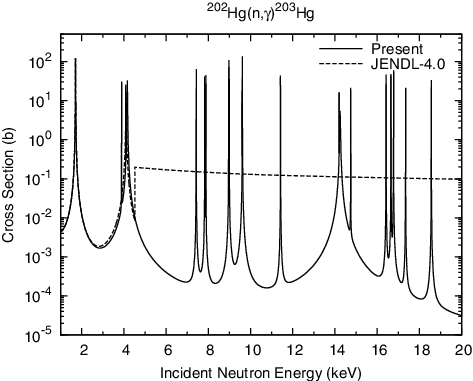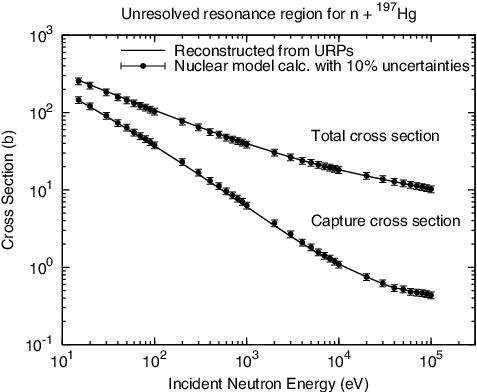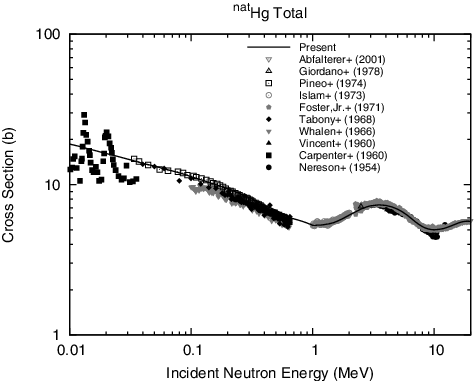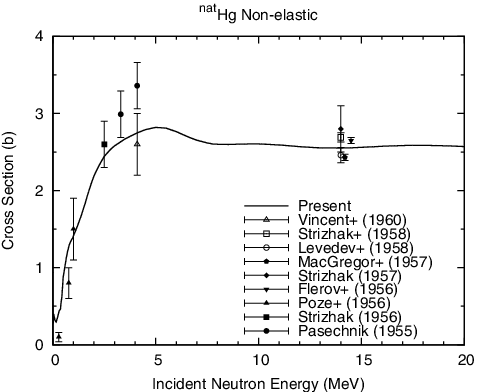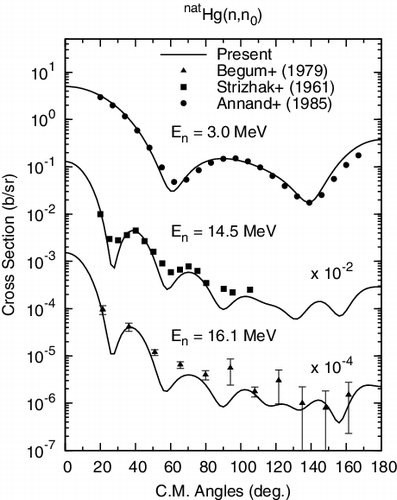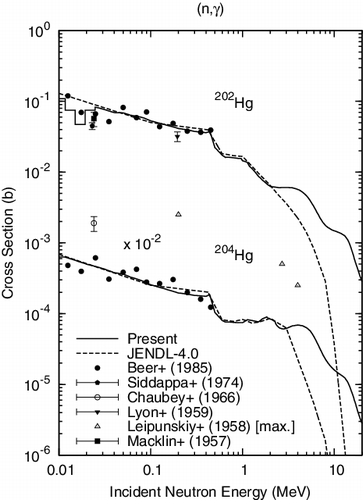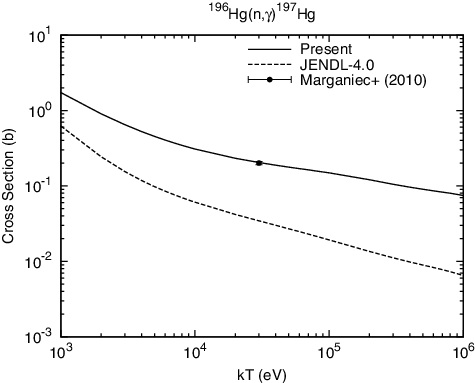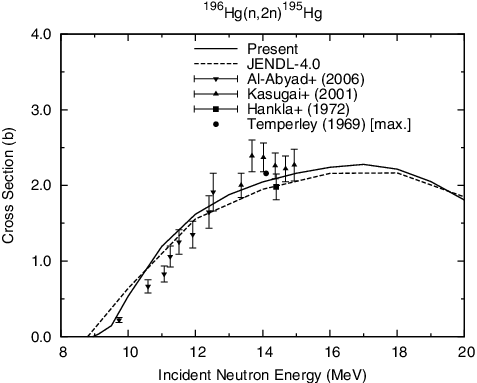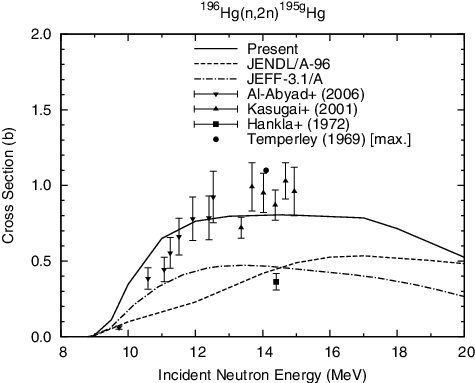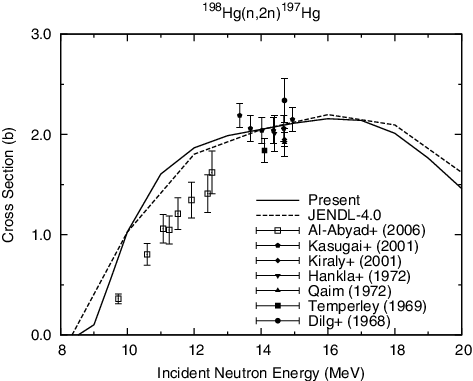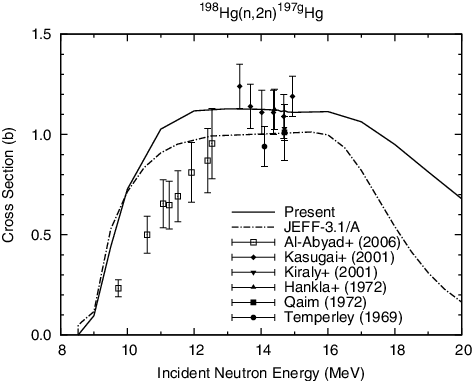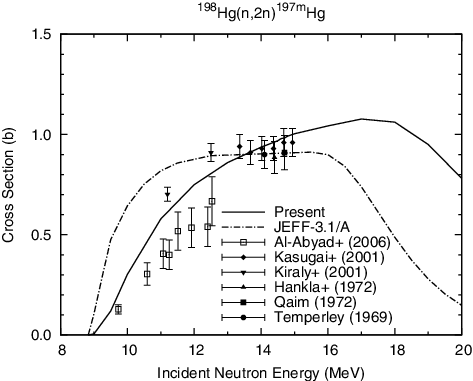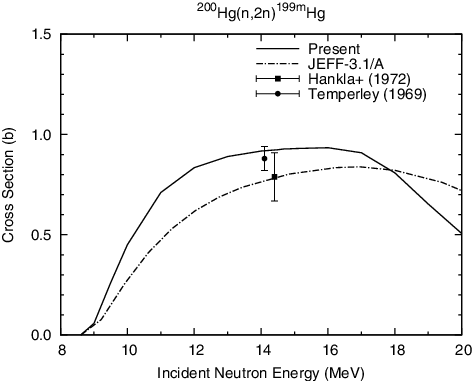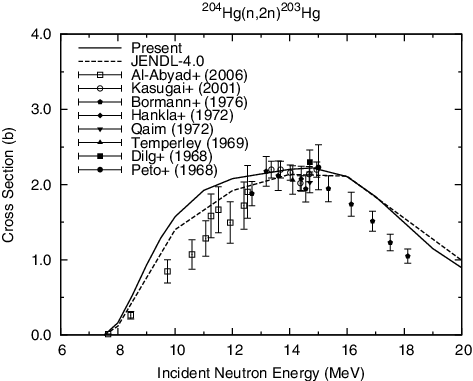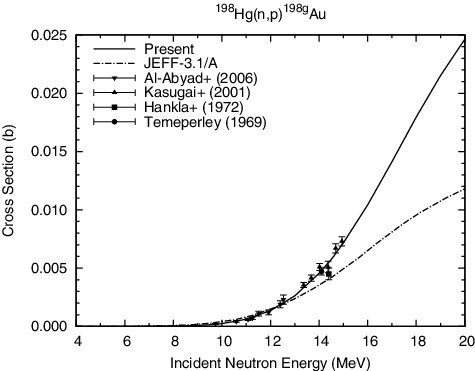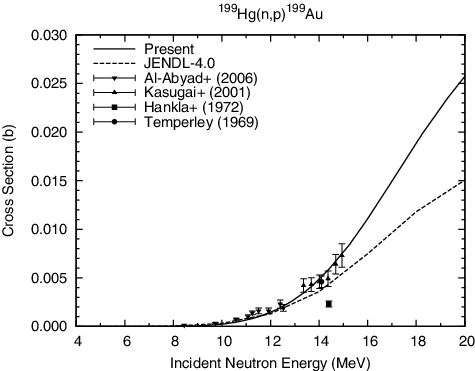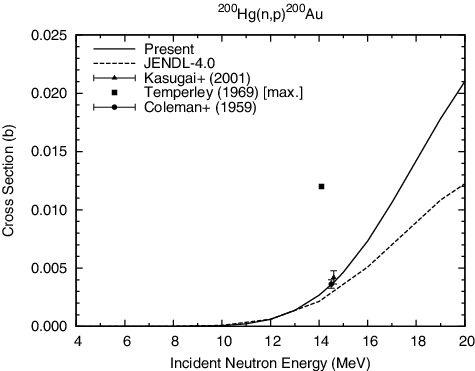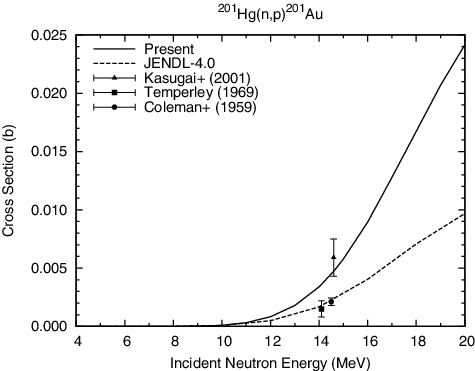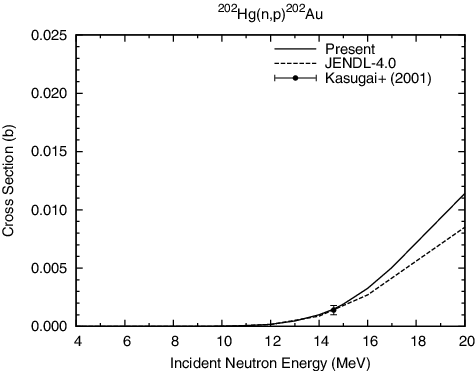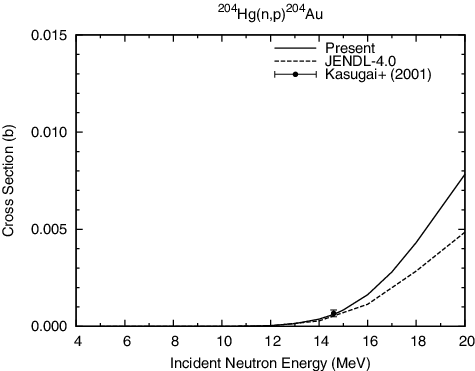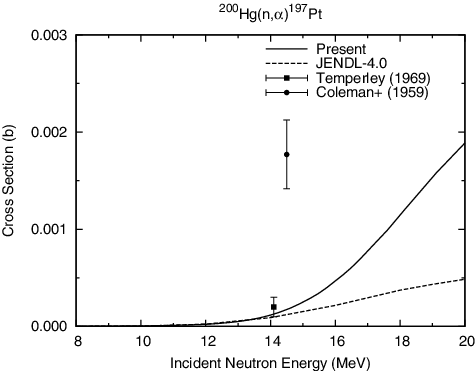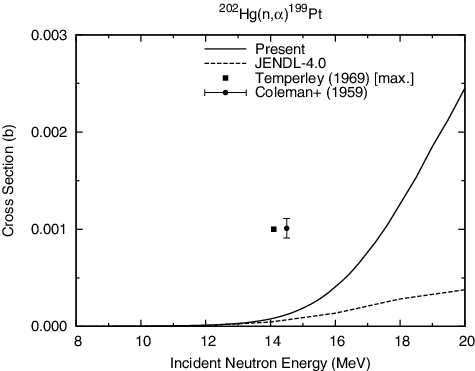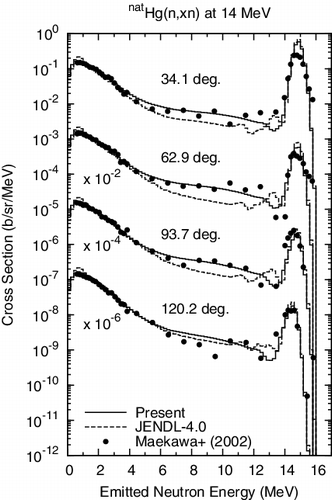 ?Mathematical formulae have been encoded as MathML and are displayed in this HTML version using MathJax in order to improve their display. Uncheck the box to turn MathJax off. This feature requires Javascript. Click on a formula to zoom.
?Mathematical formulae have been encoded as MathML and are displayed in this HTML version using MathJax in order to improve their display. Uncheck the box to turn MathJax off. This feature requires Javascript. Click on a formula to zoom.ABSTRACT
Neutron nuclear data on 10 isotopes of mercury have been evaluated for the next version of Japanese evaluated nuclear data library (JENDL) general-purpose file in the energy region from 10−5 eV to 20 MeV. Resolved resonance parameters (RRPs) for 200, 202Hg were supplemented with the data which had not been considered in the previous library. Unresolved resonance parameters (URPs) were obtained by fitting to the total and capture cross sections calculated from nuclear models. A statistical model code was applied to evaluate cross sections above the resolved resonance region. Coupled-channel optical model parameters were employed for the interaction between neutrons and nuclei except 203Hg. Compound, pre-equilibrium, and direct-reaction processes were considered for cross-section calculation in the high energy region. The present results reproduce experimental data very well. The evaluated data are compiled into evaluated nuclear data file (ENDF) formatted data files.
1. Introduction
Neutron nuclear data for mercury were evaluated [Citation1] in 1997 for (Japanese evaluated nuclear data library)JENDL-3.3 [Citation2]. The data were used to study neutron production rates, heat deposition, and shielding in a spallation-neutron target system for the J-PARC/MLF [Citation3]. The latest library JENDL-4.0 [Citation4] adopted almost the same data on mercury, although URPs were added. It is about 18 years since the data were evaluated. Recently, neutron-induced activation cross sections of mercury are required [Citation5] for the decommissioning of light-water reactors, since mercury could be contained as an impurity in the structural materials of nuclear facility. Under such circumstances, it was decided to re-evaluate the data on mercury.
The present work was undertaken to evaluate the data on 10 mercury isotopes by considering the latest knowledge on experimental and theoretical nuclear physics. Evaluated are the total, elastic, and inelastic scattering, (n, γ), (n, p), (n, d), (n, t), (n, 3He), (n, α), (n, np), (n, nd), (n, nα), (n, 2n), (n, 3n), (n, 2np) reaction cross sections, the angular distributions of elastically and inelastically scattered neutrons, and the energy distributions of emitted particles and γ-rays in the energy region from 10−5 eV to 20 MeV. The Q-values of the reactions were calculated from the mass table AME2012 [Citation6], and are listed in , together with abundances [Citation7] and half-lives [Citation8].
Table 1. Isotopic abundances and reaction Q-values of mercury isotopes.
This paper presents how the evaluation was performed. Section 2 deals with the resonance region. In Section 3, the computational method and procedures above the resonance region are described. Comparisons of the evaluated results with experimental and existing evaluated data are made in Section 4. Finally, Section 5 summarises the conclusion.
2. Resonance region
The resolved and unresolved resonance regions are listed in for each target nucleus. In JENDL-4.0, the RRPs of mercury were taken from the work of Mughabghab [Citation9], after which Beer and Macklin [Citation10] reported the RRPs of 198, 199, 200, 201, 202, 204Hg in the energy region above 2.8 keV. In the present work, the RRPs of 200, 202Hg were supplemented with the data of Beer and Macklin. shows the capture cross section of 202Hg in the resolved resonance region. As for 204Hg where no RRPs were given for JENDL-4.0, the data were taken from the work of Beer and Macklin, and a negative resonance was placed so that the calculated thermal capture cross section could reproduce the value recommended by Mughabghab [Citation11]. The RRPs of 196, 198, 199, 201Hg remain unchanged from JENDL-4.0. The RRPs of 198, 199, 201Hg obtained by Beer and Macklin were not considered, since there exists a large gap between the lowest resonance of Beer and Macklin and the highest one of JENDL-4.0. New measurements would be required to bridge the gap for further improvements of RRPs. Concerning 195, 197, 203Hg for which RRPs are unavailable, constant and 1/v energy dependences are assumed for the elastic scattering and capture cross sections, respectively, up to the lower limit of unresolved resonance region. Normalisation of the cross sections is done at thermal energy. The thermal scattering cross sections were calculated as 4πR′2, where R′ stands for the scattering radius that can be estimated from nuclear model calculations in the higher energy region. On the other hand, the thermal capture cross sections of 195, 197, 203Hg were estimated by using the simplified formula [Citation12]. This formula gives rough estimates of thermal capture cross sections by using theoretical s-wave γ-ray strength functions. It is used only when no other options are available.
Table 2. Resolved and unresolved resonance regions.
The ASREP code [Citation13] was used to determine the URPs by fitting to the total and capture cross sections calculated with the nuclear models which will be described in Section 3. The URPs obtained are used only for self-shielding calculations, since the pointwise cross sections are given in the evaluated data files. As an example, the cross sections of 197Hg reconstructed from the URPs are compared with the total and capture cross sections calculated from the nuclear models in . In the parameter fitting with the ASREP code, 10% uncertainties in the nuclear model calculations were assumed. The reconstructed cross sections reproduce the nuclear model calculations very well.
3. Computational methods and procedures above resonance region
3.1. Nuclear models
In the previous evaluation of Hg, several independent codes were used to calculate cross sections above the resonance region. After that, nuclear models have been sophisticated, and reliable model parameters could be obtained by many systematic studies. Such progress enables one to predict the cross sections more accurately than before.
In this work, the CCONE code (Version 0.8.4) [Citation14,Citation15] , which was developed for the JENDL projects, was used for calculating the neutron-induced reaction cross sections of Hg isotopes. The code is based on the spherical and coupled-channel optical models, the two-component exciton pre-equilibrium model, the distorted-wave Born approximation (DWBA), and the multi-step statistical model. In order to simulate the direct and semi-direct effects on the radiative capture reaction, the pre-equilibrium capture was considered by using the γ-ray emission rate of Akkermans and Gruppelaar [Citation16] extended to the two-component exciton pre-equilibrium model. The CCONE code is a comprehensive system designed for nuclear data evaluation, and it is similar to the TALYS [Citation17] and EMPIRE [Citation18] codes.
3.2. Parameter determination
3.2.1. Optical-model potentials
As for neutrons, we employed the global optical-model parameters obtained by Kunieda et al. [Citation19] using the coupled-channel method based on the rigid rotor model (RRM-CC) [Citation20]. The potential V(r) is defined as
(1)
(1) where L and σ are the orbital angular momentum and the Pauli matrix, respectively. The form factor fi(r) is of a Woods–Saxon shape, i.e.
(2)
(2) where Ri is written as
(3)
(3) The angle θ refers to the body-fixed system, and Y0l and βl denote spherical harmonics and a deformation parameter, respectively. The potential depths are given as follows:
(4)
(4)
(5)
(5)
(6)
(6)
(7)
(7)
(8)
(8) where Z, A, and N are the atomic number and mass number of a target and N = A − Z, respectively. The symbol E† is the incident-neutron energy (E) relative to the Fermi one (Ef), i.e. E† = E − Ef. The Fermi energy Ef is calculated from neutron-separation energies (Sn) of target and compound nuclei such as Ef = −{(Sn(Z, A) + Sn(Z, A + 1)}/2. From the neutron potentials, transmission coefficients are obtained together with total cross sections, shape elastic scattering cross sections, and the direct-reaction components of inelastic scattering cross sections for the CCONE calculation.
The parameters required in Equatios (Equation2(2)
(2) )–(Equation8
(8)
(8) ) are listed in , and the coupling schemes and deformation parameters are given in . The deformation parameters for even targets were taken from the work of Hogenbirk et al. [Citation21], while those for odd targets were taken from the theoretical work of Möller et al. [Citation22] The same neutron potentials were used as the spherical optical-model (SOM) ones for the 203Hg target, since no coupling levels were found within the framework of the rotational excitation. Vibrational excitation of the target nuclei was taken into account by DWBA using the deformation parameters given in . These βL’s of DWBA for even nuclei were essentially based on the experimental work of Hogenbirk et al. [Citation21], although those for odd nuclei were calculated using the weak coupling model [Citation23]. The calculated total and non-elastic cross sections of elemental Hg are shown in and , respectively. In order to give better fits to experimental data, the values of
and
were adjusted, while the rest of the parameters remain unchanged from the original ones [Citation19]. The measured angular distributions of neutrons elastically scattered from elemental Hg are satisfactorily reproduced by the present calculations, as seen in . Concerning charged-particles, used were the spherical parameters of Koning and Delaroche [Citation24] for protons, those of Lohr and Haeberli [Citation25] for deuterons, those of Becchetti and Greenlees [Citation26] for tritons and 3He, and those of Avrigeanu et al. [Citation27] for α-particles. The transmission coefficients, which are required by CCONE to calculate charged-particle emission, are obtained from the charged-particle parameters.
Table 3. Optical model parameters for neutrons.
Table 4. Coupling schemes used in the interaction between neutron and target.
Table 5. Deformation parameters for DWBA calculations of mercury isotopes.
3.2.2. Discrete levels and level density
In the calculation, it was necessary to input the discrete levels and level density parameters for 37 nuclei, i.e. 193−205Hg, 193−204Au, and 191 − 202Pt. The discrete levels were taken from the reference input parameters library RIPL-3 [Citation28].
Concerning the level density, the composite formula of Gilbert and Cameron [Citation29] was used in the present work. In the region of low excitation energy E, the level density is described by the constant temperature formula ρT, namely,
(9)
(9) On the other hand, the a parameter, which characterises the Fermi-gas part of level density ρF, is defined as
(10)
(10) where Esh is the shell correction energy and γ a damping factor. The damping factor is given by γ = 0.40A− 1/3MeV− 1. The energy U is expressed by E and the pairing energy Δ, i.e. U = E − Δ. In the above equations, the values of a(*) and Δ were taken from the work of Mengoni and Nakajima [Citation30]. The shell correction energy Esh is calculated as the difference between the experimental mass [Citation6] and the theoretical mass [Citation31]. The two parameters T and E0 were determined so as to connect ρF and ρT smoothly at an appropriate matching energy Em. The parameters used in this work are listed in for individual nuclei, together with the energies of the highest discrete levels
.
Table 6. Level density parameters for each nucleus.
3.2.3. Gamma-ray transition
The γ-ray transmission coefficients are related to the photoabsorption cross sections by the detailed balance. The photoabsorption cross section is usually approximated by various Lorentzian shapes. In the present calculation, a modified Lorentzian (MLO) proposed by Plujko et al. [Citation32] was used for E1 radiation, since its use is recommended by RIPL-3 [Citation28]. The resonance energy (E0), resonance width (Γ0), and peak cross section (σ0) are given [Citation33] by
(11)
(11)
(12)
(12)
(13)
(13) The standard Lorentzian (SLO) form was used to describe the M1 and E2 radiations for which the parameters were taken from the work of Kopecky and Uhl [Citation34].
In cases where measured capture cross sections are available in the keV region, the γ-ray strength functions are renormalised so that the calculated cross sections reproduce these data. The s-wave γ-ray strength functions are compared in with the values recommended by Mughabghab [Citation11]. The values of 197, 199, 200, 202, 203, 205Hg were obtained after renormalisation using measurements.
Table 7. Gamma-ray strength functions for s-wave neutron in units of 10−4.
3.2.4. Pre-equilibrium parameters
The Version 0.8.4 of CCONE incorporates pre-equilibrium process for the (n, γ) and first-step binary reactions such as (n, n′), (n, p), (n, d), (n, t), (n, 3He), and (n, α). In the two-exciton pre-equilibrium formalism, the single-particle state densities for protons and neutrons in a residual nucleus are described [Citation35] by
(14)
(14)
(15)
(15) respectively. The parameter C0, of which the default value is unity, is changed so that the calculations reproduce measured neutron and proton emission data such as (n, 2n) and (n, p) in the present work. The (n, 2n) reaction is a ternary reaction, which proceeds from (n, n′) by sequential decay in the framework of the multi-step statistical model. Hence, the (n, 2n) cross section is sensitive to C0 for the residual nucleus in the (n, n′) reaction. More experimental data are available for (n, 2n) than for (n, n′) in the nuclides presently concerned. In addition to the C0’s, the pre-equilibrium parameters for complex-particle emission [Citation36] were adjusted for α emission. The pre-equilibrium parameters used are listed in , where C0’s are given only for the residual nuclei in the (n, n′) and (n, p) reactions, and are assumed to be unity for those in the other first-step binary reactions.
Table 8. Pre-equilibrium parameters.
4. Comparison with experimental data and other evaluated data in the fast-neutron region
Comparisons are made with experimental data and other evaluated data. The experimental data are taken from the EXFOR database [Citation37] that is compiled by the international data centres such as the IAEA Nuclear Data Section, the OECD NEA Data Bank, and the National Nuclear Data Center at the Brookhaven National Laboratory. As for the general-purpose evaluated nuclear data, JENDL-4.0 [Citation4], ENDF/B-VII.1 [Citation38] and JEFF-3.2 [Citation39] contain the data for 196, 198, 199, 200, 201, 202, 204Hg. The libraries ENDF/B-VII.1 and JEFF-3.2 took cross sections from JENDL-4.0 below 20 MeV. Therefore, they are not independent of one another. To avoid duplication, the JENDL-4.0 data are solely used to compare with the present data. These general-purpose libraries do not contain activation cross sections leading to the ground or isomeric state. The activation files JENDL/A-96 [Citation40] and JEFF-3.1/A [Citation41] are used for comparison with such activation data. Concerning the 199Hg(n, n′)199mHg reaction, the dosimetry file IRDFF-1.05 [Citation42] is included in the comparison. We do not discuss most of the reactions where experimental data are unavailable, since it is difficult to judge whether the present evaluation is reasonable without measurements.
The capture cross sections of 198, 199, 200, 201Hg and 202, 204Hg are illustrated in and , respectively. It is found from the figures that the present evaluation is in good agreement with the data measured by Beer and Macklin [Citation10]. In the MeV region, the JENDL-4.0 evaluation is considerably smaller than the present data, since the pre-equilibrium capture is not taken into account in JENDL-4.0. There exist no experimental data on 196Hg with mono-energetic neutrons in the keV region. Alternatively, we used the measured Maxwellian-averaged cross section [Citation43] at kT = 30 keV to renormalise the γ-ray strength function, as shown in . The calculated elemental cross section is compared with measured data and the JENDL-4.0 evaluation in , where the open and closed symbols stand for neutron and γ-ray measurements, respectively. The present results are almost consistent with the γ-ray measurements, whereas the data obtained by the shell transmission method [Citation44], i.e. the neutron measurements, are systematically larger than the present and JENDL-4.0 evaluations.
Figure 9. Capture cross section of natHg. The open and closed symbols stand for neutron and γ-ray measurements, respectively.

shows the 199Hg(n, n′)199mHg cross section, which is regarded as one of the dosimetry cross sections. In the figure, the data of Grudzevich et al. [Citation45] were corrected for the 200Hg(n, 2n)199mHg contribution estimated in this work. The present evaluation is almost consistent with the data measured by Sakurai et al. [Citation46] above 3 MeV. However, it cannot reproduce the data of Sakurai et al. obtained below 3 MeV, and is rather close to the data of Swann and Metzger [Citation47]. Two 2.8-MeV measurements [Citation48,Citation49] are obviously much lower than the present and JEFF-3.1/A evaluations. The IRDFF-1.05 data are based on a least-squares fit to the renormalised experimental data below 10 MeV, although the theoretical calculations were taken into account above 10 MeV. The present evaluation yields the dosimetry cross sections by placing much emphasis on the theoretical understanding of the reaction.
Figure 10. 199Hg(n, n′)199mHg reaction cross section. The data of Grudzevich et al. [Citation45] were corrected for the 200Hg(n, 2n)199mHg cross section estimated in the present work.
![Figure 10. 199Hg(n, n′)199mHg reaction cross section. The data of Grudzevich et al. [Citation45] were corrected for the 200Hg(n, 2n)199mHg cross section estimated in the present work.](/cms/asset/3b7b0260-8614-421c-8a34-b74fb693daaf/tnst_a_1140599_f0010_b.gif)
– show the (n, 2n) reaction cross sections. As for 196Hg(n, 2n), the present evaluation is consistent with the measured data on the ground- and isomeric-state production. The activation files JENDL/A-96 and JEFF-3.1/A are systematically smaller than the measured data on the ground-state production. In the present parametrisation, it is not possible to simultaneously fit the data measured by Al-Abyad et al. [Citation50] below 12.5 MeV and the other data around 14 MeV for the 198, 204Hg(n, 2n) reactions. We placed emphasis on the 14-MeV measurements obtained by several experiments. In the experiment of Al-Abyad et al., quasi-monoenergetic neutrons produced via the 2H(d, n)3He were incident on a natural Hg target, and so 197Hg and 203Hg could be formed by the 196Hg(n, γ) and 202Hg(n, γ) reactions, respectively, due to the low-energy breakup neutrons having continuous energies. These contributions were corrected in the experiment, but it is not certain whether the corrections were appropriate. It is suggested that more experiments should be performed in the energy region below 14 MeV.
Charged-particle emission cross sections are illustrated in –. As seen from , the pre-equilibrium parameters for (n, p) are not drastically changed from the default value, i.e. unity. The present evaluation agrees with the 14-MeV data measured by Kasugai et al. [Citation51] On the other hand, the pre-equilibrium effects were much enhanced for (n, α). We could reproduce the data of Temperley [Citation52] for 200Hg, although the data of Coleman et al. [Citation53] that were obtained by the β counting are too high. However, the 202Hg case was obviously unsuccessful. As a matter of fact, Temperley could not observe 544-keV γ-rays due to the decay of 199Pt. Then, the author set an upper limit of 1 mb for 202Hg(n, α)199Pt in order to deduce the 199Hg(n, p)199Au cross section, since the residual nucleus 199Pt decays to 199Au. It is unlikely that the 14-MeV cross section could reach 1 mb by comparing with the 200Hg(n, α) cross section. Therefore, the data of Coleman et al. for 202Hg(n, α) might be overestimated as in the case of 200Hg.
The double-differential neutron emission spectra from elemental Hg are depicted in . The presently calculated cross sections are in good agreement with the data measured by Maekawa et al. [Citation54] at 14 MeV. The JENDL-4.0 evaluation underestimates the spectra at forward angles, since symmetric angular distributions are given for neutrons inelastically scattered from the overlapping levels. In the present work, forward peaking is assumed by using the systematics of Kalbach [Citation55].
5. Concluding remarks
The neutron nuclear data on Hg isotopes were evaluated in the energy region from 10− 5 eV to 20 MeV. The RRPs of 200, 202, 204Hg were revised by considering the latest measurements, while those of 196, 198, 199, 201Hg remain unchanged from JENDL-4.0. However, more resonance experiments would be needed to improve the low-energy cross section. As for 195, 197, 203Hg whose RRPs are unavailable, constant and 1/v energy dependences are assumed for the low-energy elastic scattering and capture cross sections, respectively. The URPs were obtained for self-shielding calculations by fitting to the total and capture cross sections calculated from the nuclear models.
Above the resolved resonance region, the present evaluation is based on the statistical model using the CCONE code. The neutron transmission coefficients were obtained by the RRM-CC or the SOM, together with the total and shape-elastic scattering cross sections. The neutron potentials were found to be reliable by comparing with measured total and non-elastic cross sections of elemental Hg. On the whole, the presently evaluated cross sections are in good agreement with available experimental data, and better than the JENDL-4.0 data. However, it was not possible to reproduce the measured 198, 204Hg(n, 2n) cross sections below 12.5 MeV. More experimental data would be desired to resolve the difference in this energy region.
The evaluated data are compiled into ENDF-formatted data files and will be available in the next release of JENDL general purpose file. Part of the cross sections are used as activation data for the decommissioning of light-water reactors.
Acknowledgments
The author would like to thank the members of the Nuclear Data Center, JAEA, for their helpful comments on this work.
Disclosure statement
No potential conflict of interest was reported by the author.
References
- Shibata K, Fukahori T, Chiba S, et al. Evaluation of neutron nuclear data for mercury. J Nucl Sci Technol. 1997;34:1171–1177.
- Shibata K, Kawano T, Nakagawa T, et al. Japanese evaluated nuclear data library version 3 revision-3: JENDL-3.3. J Nucl Sci Technol. 2002;39:1125–1136.
- http://j-parc.jp/MatLife/en/index.html
- Shibata K, Iwamoto O, Nakagawa T, et al. JENDL-4.0: a new library for nuclear science and engineering. J Nucl Sci Technol. 2011;48:1–30.
- IAEA Safety Standards Series. Application of the concepts of exclusion, exemption and clearance (No. RS-G-1.7). Vienna: International Atomic Energy Agency; 2004.
- Wang M, Audi G, Wapstra AH, et al. The AME2012 atomic mass evaluation (II). Tables, graphs and references. Chinese Phys C. 2012;36:1603–2014.
- Berglund M, Wieser ME. Isotopic compositions of the elements 2009. Pure Appl Chem. 2011;83:397–410.
- Tuli JK. Nuclear wallet cards. 8th ed. Upton, NY: Brookhaven National Laboratory; 2011.
- Mughabghab SF. Neutron cross sections. Vol 1. Neutron resonance parameters and thermal cross sections, Part B: Z=61–100. Orlando: Academic Press; 1984.
- Beer H, Macklin RL. 198, 199, 200, 201, 202, 204Hg(n, γ) cross sections and the termination of s-process nucleosynthesis. Phys Rev C. 1985;32:738–755.
- Mughabghab SF. Atlas of neutron resonances, resonance parameters and thermal cross sections Z = 1–100. Amsterdam: Elsevier; 2006.
- Shibata K. Evaluation of neutron nuclear data on antimony isotopes. J Nucl Sci Technol. 2014;51:425–436.
- Kikuchi Y, Nakagawa T, Nakajima Y. ASREP: a computer program for automatic search of unresolved resonance parameters. Tokai: Japan Atomic Energy Research Institute; 1999. JAERI-Data/Code 99-025, Japanese.
- Iwamoto O. Development of a comprehensive code for nuclear data evaluation, CCONE, and validation using neutron-induced cross sections for uranium isotopes. J Nucl Sci Technol. 2007;44:687–697.
- Iwamoto O, Iwamoto N, Kunieda S, et al. The CCONE code system and its application to nuclear data evaluation for fission and other reactions. Nucl Data Sheets. 2016;131:259–288.
- Akkermans JM, Gruppelaar H. Analysis of continuum gamma-ray emission in precompound-decay reactions. Phys Lett B. 1985;157:95–100.
- Koning A, Hilaire S, Goriely S. TALYS-1.6: a nuclear reaction program. Petten: Nuclear Research and Consultancy Group; 2013.
- Herman M, Capote R, Carlson BV, et al. EMPIRE: nuclear reaction model code system for data evaluation. Nucl Data Sheets. 2007;108:2655–2715.
- Kunieda S, Chiba S, Shibata K, et al. Coupled-channels optical model analyses of nucleon-induced reactions for medium and heavy nuclei in the energy region from 1 keV to 200 MeV. J Nucl Sci Technol. 2007;44:838–852.
- Tamura T. Analyses of the scattering of nuclear particles by collective nuclei in terms of the coupled-channel calculation. Rev Mod Phys. 1965;37:679–708.
- Hogenbirk A, Blok HP, Harakeh MN. Inelastic proton scattering from 198Hg, 200Hg, 202Hg and 204Hg at Ep = 28 MeV. Nucl Phys A. 1991;524:251–284.
- Möller P, Nix JR, Myers WD, et al. Nuclear ground-state masses and deformations. Atom Data Nucl Data Tables. 1995;59:185–381.
- Hodgson PE. Nuclear reactions and nuclear structure. Oxford: Clarendon Press; 1971. p. 386–392.
- Koning AJ, Delaroche JP. Local and global nucleon optical models from 1 keV to 200 MeV. Nucl Phys A. 2003;713:231–310.
- Lohr JM, Haeberli W. Elastic scattering of 9–13 MeV vector polarized deuterons. Nucl Phys A. 1974;232:381–397.
- Becchetti FD, Greenlees GW. A general set of 3He and triton optical-model potentials for A > 40, E < 40 MeV. In: Barshall HH, Haeberli W, editors. Proceedings of the Third International Symposium on Polarization Phenomena in Nuclear Reactions; 1970 August 31-September 4; Madison, Wisconsin: University of Wisconsin Press; 1971. p. 682–683.
- Avrigeanu V, Hodgson PE, Avrigeanu M. Global optical potentials for emitted alpha particles. Phys Rev C. 1994;49:2136–2141.
- Capote R, Herman M, Obložinský P, et al. RIPL–reference input parameter library for calculations of nuclear reactions and nuclear data evaluations. Nucl Data Sheets. 2009;110:3107–3214.
- Gilbert A, Cameron AGW. A composite nuclear-level density formula with shell corrections. Can J Phys. 1965;43:1446–1496.
- Mengoni A, Nakajima Y. Fermi-gas model para-metrization of nuclear level density. J Nucl Sci Technol. 1994;31:151–162.
- Myers WD, Swiatecki WJ. Nuclear masses and deformations. Nucl Phys. 1966;81:1–60.
- Plujko VA, Ezhov SN, Kavatsyuk MO, et al. Testing and improvements of gamma-ray strength functions for nuclear model calculations. J Nucl Sci Technol. 2002;Supplement 2:811–814.
- Kopecky J. Gamma-ray strength functions (IAEA-TECDOC-1034). Vienna: International Atomic Energy Agency; 1998. p. 97–111.
- Kopecky J, Uhl M. Test of gamma-ray strength functions in nuclear model calculations. Phys Rev C. 1990;41:1941–1955.
- Koning AJ, Duijvestijn MC. A global pre-equilibrium analysis from 7 to 200 MeV based on the optical model potential. Nucl Phys A. 2004;744:15–76.
- Kalbach C. The Griffin model, complex particles and direct reactions. Z Phys A. 1977;283:401–411.
- Otuka N, Dupont E, Semkova V, et al. Towards a more complete and accurate experimental nuclear reaction data library (EXFOR): international collaboration between nuclear reaction data centres (NRDC). Nucl Data Sheets. 2014;120:272–276.
- Chadwick MB, Herman M, Obložinský P, et al. ENDF/B-VII.1 nuclear data for science and technology: cross sections, covariances, fission product yields and decay data. Nucl Data Sheets. 2011;112:2887–2996.
- OECD Nuclear Energy Agency Data Bank. Available from http://www.oecd-nea.org/dbforms/data/eva/evatapes/jeff_32/
- Nakajima Y. JENDL activation cross section file. In: Igashira M, Nakagawa T, editors. Proceedings of the 1990 Symposium on Nuclear Data; 1990 November 29–30; Tokai, Japan: Japan Atomic Energy Research Institute; 1991. p. 43–57 ( JAERI-M 91-032).
- Koning A, Forrest R, Kellet M, et al., editors. The JEFF-3.1 nuclear data library. Paris: OECD Nuclear Energy Agency; 2006. ( JEFF Report 21).
- Zsolnay EM, Capote R, Nolthenius HJ, et al. Summary description of the new international reactor dosimetry and fusion file (IRDFF release 1.0). Vienna: International Atomic Energy Agency; 2012, INDC(NDS)-0616.
- Marganiec J, Dillmann I, Domingo Pardo C, et al. Stellar (n, γ) cross sections of p-process isotopes. II. 168Yb, 180W, 184Os, 190Pt, and 196Hg. Phys Rev C. 2010;82:035806.
- Schmitt HW, Cook CW. Absolute neutron absorption cross sections for Sb-Be photoneutrons. Nucl Phys. 1960;20:202–219.
- Grudzevich OT, Kagalenko AB, Kornilov NV, et al. 199mHg isomer yield in the reactions 199Hg(n, n′) and 200Hg(n, 2n). Proceedings of 1st International Conference on Neutron Physics; 1987, Sep 14–16. Kiev, USSR. 349–353, Russian.
- Sakurai K, Gotoh H, Yamamoto S, et al. Cross section measurement for 199Hg(n, n′)199mHg reaction from 0.78 to 6.3 MeV. J Nucl Sci Technol. 1982;19:775–780.
- Swann CP, Metzger FR. Production of Y89m, Ba137m and Hg199m by inelastic neutron scattering. Phys Rev. 1955;100:1329–1333.
- Broadhead KG, Shanks DE. Application of 2.8-MeV (D,d) neutrons to activation analysis. Int J Radiat Isotopes. 1967;18:279–283.
- Bornemisza-Pauspertl P, Karolyi J, Peto G. Measurements of the excitation cross sections of isomeric states by scattering of 2.8 MeV neutrons. Atomki Koezlemenyek. 1968;10:112–114.
- Al-Abyad M, Sudár S, Comsan MNH, et al. Cross sections and isomeric cross-section ratios in the interactions of fast neutrons with isotopes of mercury. Phys Rev C. 2006;73:064608.
- Kasugai Y, Maekawa F, Ikeda Y, et al. Measurement of activation cross sections for mercury isotopes in the neutron energy range between 13.4 and 14.9 MeV. J Nucl Sci Technol. 2001;38:1048–1056.
- Temperley JK. Neutron activation cross sections for mercury isotopes at 14.1 MeV. Phys Rev. 1969;178:1904–1910.
- Coleman RF, Hawker BE, O’connor LP, et al. Cross sections for (n, p) and (n, α) reactions with 14.5 MeV neutrons. Proc Phys Soc (Lond). 1959;73:215–220.
- Maekawa F, Meigo S, Kasugai Y, et al. Experimental study on cross section data of mercury with D-T and 252Cf neutron sources. J Nucl Sci Technol. 2002;Supplement 2:986–989.
- Kalbach C. Systematics of continuum angular distributions: extensions to higher energies. Phys Rev C. 1988;37:2350–2370.

